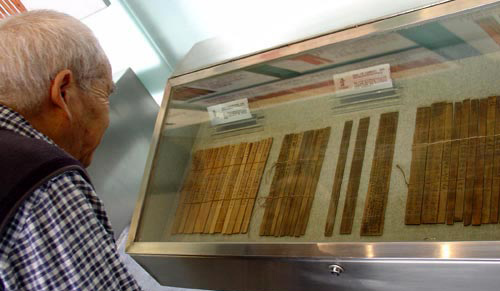Landmark dictionary to enhance bamboo script studies

A visitor observes bamboo scripts at Changsha Bamboo Slips Museum in Hunan Province. Bamboo strips were one of the main media for literacy in ancient China, with a history of more than 2,000 years.
Researchers have begun compiling the world’s first bamboo script studies dictionary. The project is sponsored by the National Social Sciences Fund and was launched at Jilin University on March 22. Bamboo and wooden scrolls were used for inscriptions for more than 2,000 years in ancient China.
Bamboo and wooden scrolls were eventually replaced due to the development and popularization of paper, but bamboo scripts have made indelible contributions to Chinese history and culture, drawing great attention from academia at home and abroad.
Renowned Chinese scholars Luo Zhenyu (1866-1940) and Wang Guowei (1877-1927) were pioneers in studying bamboo scripts. After decades of rapid development, bamboo scripts have become a well-known subject for academics, crossing disciplines such as history, archaeology, archeography and language philology.
According to Feng Shengjun, chief expert of the Bamboo Script Dictionary project and director of the Institute of Ancient Books at Jilin University, a considerable number of bamboo inscriptions have been unearthed in China, Japan and South Korea.
In addition to successive excavations of bamboo inscriptions, the publication of numerous volumes related to bamboo script studies and advancement of image processing technology have highlighted the need for a bamboo script dictionary to facilitate relevant research.
Bamboo inscriptions are also a focus of attention in the international Sinology community.
In order to support studies of bamboo scripts overseas, the team behind the project has invited professors from German, Japanese and South Korean universities to take charge of academic content from their countries, said Hu Pingsheng, a research fellow from the Chinese Academy of Cultural Heritage.
“The collaboration between Chinese and foreign scholars will further enhance international exchanges on bamboo script studies,” Hu said.
Scholars predict the dictionary will feature illustrations introducing concepts and theories in bamboo script studies; the origin and evacuation history, shape and features; the sorting and protection techniques of bamboo slips; the evolution of bamboo inscriptions, and more.
Geng Xue is a reporter at the Chinese Social Sciences Today.
